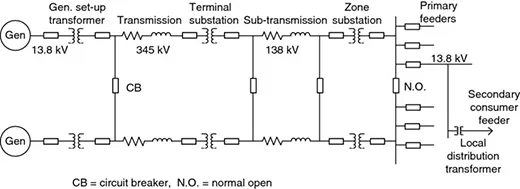
- English
- ePUB (mobile friendly)
- Available on iOS & Android
Electric Distribution Systems
About this book
A comprehensive review of the theory and practice for designing, operating, and optimizing electric distribution systems, revised and updated
Now in its second edition, Electric Distribution Systems has been revised and updated and continues to provide a two-tiered approach for designing, installing, and managing effective and efficient electric distribution systems. With an emphasis on both the practical and theoretical approaches, the text is a guide to the underlying theory and concepts and provides a resource for applying that knowledge to problem solving. The authors—noted experts in the field—explain the analytical tools and techniques essential for designing and operating electric distribution systems. In addition, the authors reinforce the theories and practical information presented with real-world examples as well as hundreds of clear illustrations and photos.
This essential resource contains the information needed to design electric distribution systems that meet the requirements of specific loads, cities, and zones. The authors also show how to recognize and quickly respond to problems that may occur during system operations, as well as revealing how to improve the performance of electric distribution systems with effective system automation and monitoring. This updated edition:
• Contains new information about recent developments in the field particularly in regard to renewable energy generation
• Clarifies the perspective of various aspects relating to protection schemes and accompanying equipment
• Includes illustrative descriptions of a variety of distributed energy sources and their integration with distribution systems
• Explains the intermittent nature of renewable energy sources, various types of energy storage systems and the role they play to improve power quality, stability, and reliability
Written for engineers in electric utilities, regulators, and consultants working with electric distribution systems planning and projects, the second edition of Electric Distribution Systems offers an updated text to both the theoretical underpinnings and practical applications of electrical distribution systems.
Frequently asked questions
- Essential is ideal for learners and professionals who enjoy exploring a wide range of subjects. Access the Essential Library with 800,000+ trusted titles and best-sellers across business, personal growth, and the humanities. Includes unlimited reading time and Standard Read Aloud voice.
- Complete: Perfect for advanced learners and researchers needing full, unrestricted access. Unlock 1.4M+ books across hundreds of subjects, including academic and specialized titles. The Complete Plan also includes advanced features like Premium Read Aloud and Research Assistant.
Please note we cannot support devices running on iOS 13 and Android 7 or earlier. Learn more about using the app.
Information
PART I
FUNDAMENTAL CONCEPTS
CHAPTER 1
INTRODUCTION
1.1 Introduction and Background
1.2 Power System Structure


Table of contents
- Cover
- Title Page
- Copyright
- Preface
- Acknowledgments
- Part I: Fundamental Concepts
- Part II: Protection and Switchgear
- Part III: Power Quality
- Part IV: Management and Automation
- Part V: Distributed Energy Resources and Microgrids
- Appendix A: Data of Microgrid Components
- Appendix B: Matlab Simulink Models
- References
- Index
- IEEE Press Series on Power Engineering
- Wiley End User License Agreement